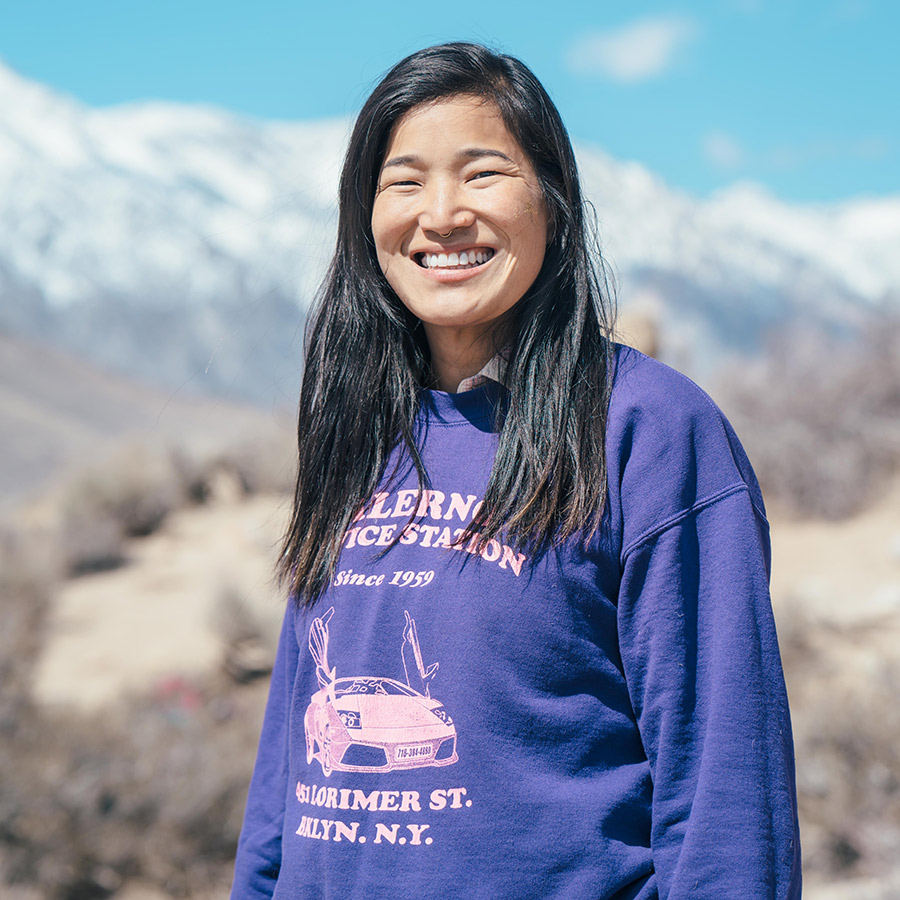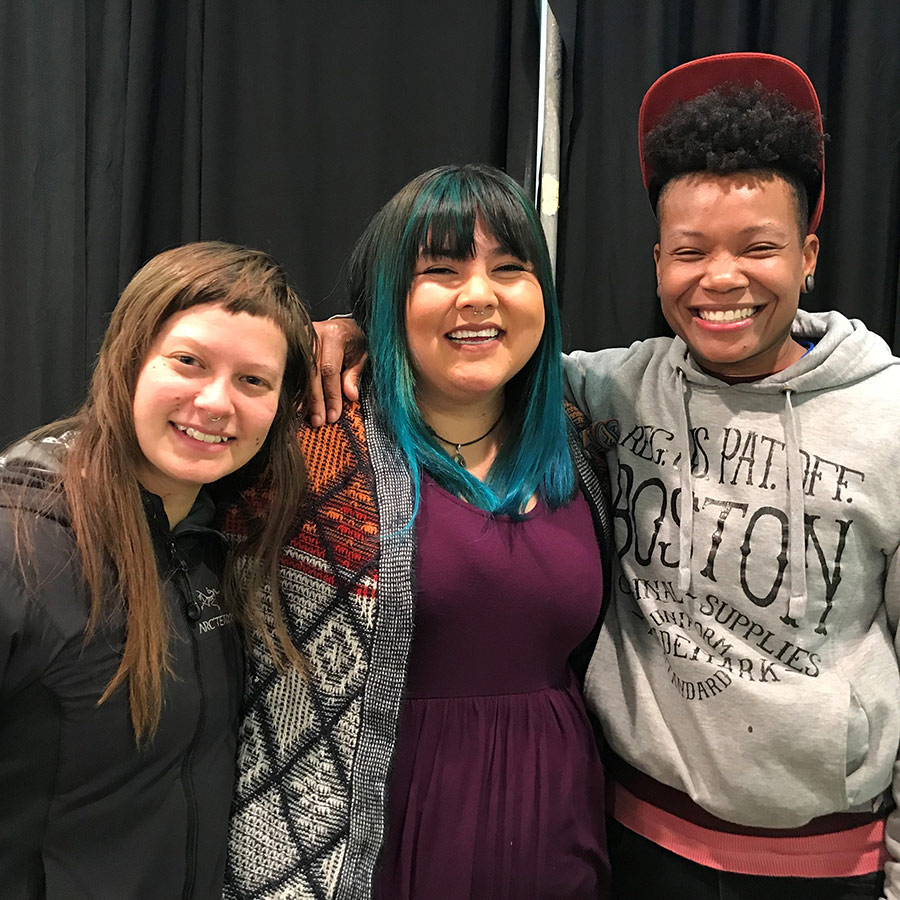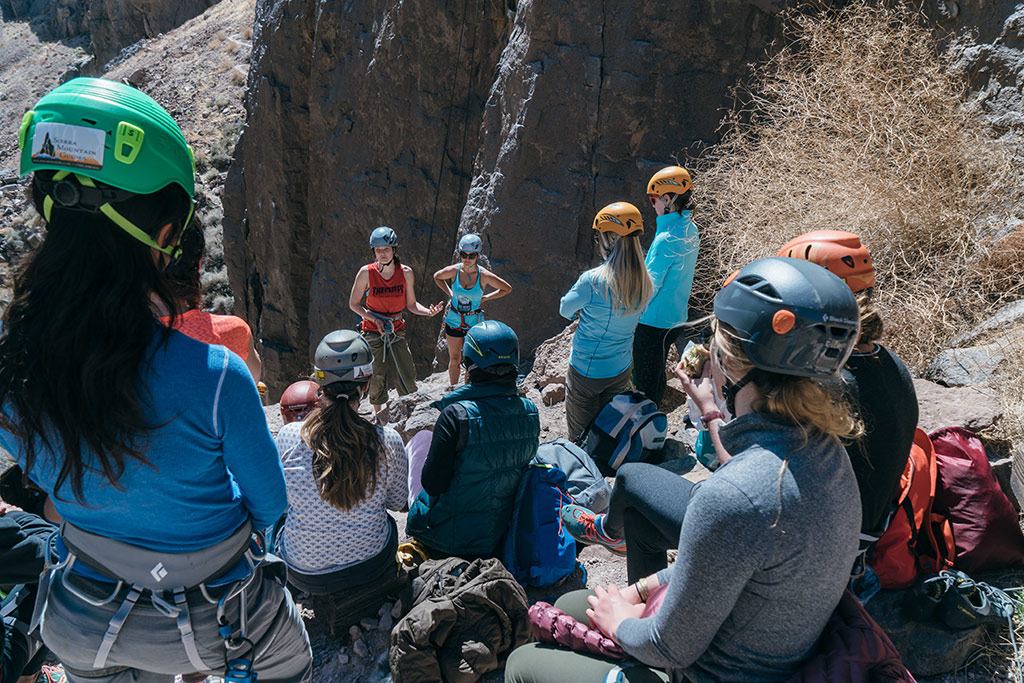Editor’s note: REI is a sponsor of both of Flash Foxy’s Women’s Climbing Festivals this year: Bishop on March 22-24, 2019 and Chattanooga (dates to be announced).
Summer Winston didn’t start climbing until she was 33, a year after she camped for the first time. In her family, you didn’t go into the woods voluntarily because you might not come back out. The woods is where men from their New Orleans neighborhood disappeared in the 1960s and ’70s.
“The swamps and the woods became these places you were warned against,” Winston says now. “My 67-year-old cousin would tell me about these guys that would find themselves in opposition to either law enforcement or ‘backwoods white boys,’ and nobody ever saw them again. It was this idea that groups like the Ku Klux Klan and others with insidious intent conducted business in the woods, away from watchful eyes.”
Winston had grown up playing outside in urban spaces in southern Louisiana, but camping, which she discovered through a former partner, offered a unique reprieve from the buzz of civilization. She got to know nature on its own, and she was hooked. But with a history of violence perpetrated against Black people in the woods, Winston’s family was not quiet about how she spent her free time. “They thought it was weird, to say the least,” Winston says, but she kept pursuing new outdoor activities because they provided a space where “could turn off all the sounds.” Being active outdoors gave her a peace and solace she couldn’t find in an urban environment.
During one dangerous off-trail experience, when Winston found herself on the side of a steep cliff, her first thought was that some climbing skills would have come in handy. When she got back into cell phone range, she purchased a discounted 30-day Groupon pass to Stone Moves, a climbing gym in Houston.
“We believe everyone deserves to feel like they belong somewhere.”
—Summer Winston
A few weeks later, when she walked through the doors of the gym, she didn’t see any people who looked like her or any of her friends. “Most of my non-climbing time was spent surrounded by people of color,” she says. “So walking into a gym space, session after session, to an environment so different from what my life looked like was tough. I almost stopped showing up.” But Winston loved the feeling of being on the wall, just herself and the physical challenge of the next move. Stress from work, life, family and relationship issues just melted away when she was climbing. In October of last year, she found herself at a Color the Crag event in Horse Pens 40, a popular climbing destination in Alabama.
“For me it was like an epiphany, being around all these Brown and Black folks, geeking out about climbing, and feeling comfortable in my skin,” she says. “It made me acutely aware that I had never felt that before in a climbing space.”
She wanted to carry that feeling home with her and provide it for other climbers of color, so in October 2017, Winston partnered up with Touchstone Climbing, which owns and operates 12 gyms in California, to start The Brown Ascenders. The group builds a community for climbers of color in the Bay Area by hosting workshops, climbing nights and demo series.
“I wanted us to create a space where other Brown and Black folks could feel even a fraction of what that [Color the Crag] environment felt like,” she says. “Our goal is to build community both locally and across the country. We believe everyone deserves to feel like they belong somewhere.”
***
It was at the same Color the Crag event in Alabama that Winston met Shelma Jun, 35. Four years ago, Jun had started an Instagram account, @heyflashfoxy, to post pictures of her female climber friends in an effort to celebrate women climbing with women. When Jun started receiving dozens of messages from women climbers asking about how they could be a part of it, she began to expand the Flash Foxy online platform and eventually founded the Women’s Climbing Festival. The inaugural event, held in March 2016 in Bishop, California, offered a space for women to come together, climb and connect.

Shelma Jun founded the Women’s Climbing Festival in 2016. (Photo Credit: Julie Ellison)
After the first Bishop gathering, it was clear that many women climbers were eager to explore the camaraderie and joy of climbing with other women. When tickets to the second festival in Bishop in 2017 sold out in one minute with more than 800 women on the waiting list, Jun decided to add another festival in Chattanooga, Tennessee. In 2018, a total of 350 women attended the Bishop event, held March 23–25, with 496 people on the waiting list. With about 350 expected attendees, the Chattanooga festival will be held October 12–14, 2018.
As the festival continues to grow, it’s clear that the women’s climbing community is no longer a hypothetical group discussed in online forums and on social media. The festival had given it names and faces, and with that, the power to take action. The past two years’ festivals built and gained momentum for the larger community of women climbers, but groups within that community, like Winston and fellow climbers of color, did not experience the same progress.
“Climbers of color tell stories of feeling alone in their gyms, of being called ‘the Brown girl’…of feeling out of place, of having to fit a certain mold to keep other people comfortable,” Winston says.

Photo Credit: Julie Ellison
At each festival, the discussion panel is a seminal event. The first year’s panel focused on the general conversation about women in climbing, with topics like controversy over first female ascents and sexism, whereas the 2017 panels in Bishop and Chattanooga centered on women who were making moves in male-dominated areas of the sport (topics included alpine first ascents, route setting in gyms and corporate management). Although many aspects of diversity had been mentioned in previous years’ panels, Jun decided to bring the discussion to the forefront of the 2018 Bishop festival.
“We’re coming together at the Women’s Climbing Festival because we feel excluded and disconnected from the mainstream climbing culture,” Jun says, “and I wanted to highlight that even within our community of women, there are women of color that still feel excluded and disconnected. If anyone should understand how that feels and want to change it, it should be us.”
The members of the Bishop panel were Winston, Mailee Hung, director of outreach and communications for Touchstone Climbing, and Jolie Varela, founder of Indigenous Women Hike, with Jun acting as moderator. The three panelists offered perspectives as women and people of color and how that’s shaped their experiences within the climbing world.’

Mailee Hung, Jolie Varela and Summer Winston at the Women’s Climbing Festival in Bishop, California. (Photo Courtesy: Summer Winston)
Varela, a Bishop local, kicked off the panel discussion by talking about the Indigenous people in Payahüünadü (Owens Valley). She says most outdoor recreationists who come to the area don’t realize that five tribes have inhabited the land long before there was climbing. “There’s a grinding stone used by Indigenous people on the hike to the Happies [climbing area],” Varela says, “but climbers just step right on it and have no idea.” Varela spoke of her connection to the land and how her grandparents were born at the base of the Sierra Nevada, right outside of Bishop. Despite her ancestral connection, she didn’t develop her own relationship with the land until she started hiking at age 26. After awhile, she noticed that she rarely saw people of color on the trail.
“I often thought climbers and other recreators never seemed to acknowledge the first people of the land,” she says. “There’s this privilege in living the ‘dirtbag’ lifestyle, the idea that you have the freedom to travel to whatever destination and make it home while there’s a whole race of people that have been displaced from those very same spaces. It definitely makes you think.”
Every Sunday, Varela brings friends and family out hiking, strengthening their connection to the land and to each other. They take children out hiking and climbing with the hopes that they’ll inspire their families to love the outdoors too. In May 2017, Varela stared Indigenous Women Hike, a collective of 12 Indigenous women who, in August 2018, will hike 210 miles of ancestral trade routes, the Nüümü Poyo, otherwise known as the John Muir Trail. Their goals: raise awareness of Indigenous issues and reconnect with these sacred spaces.
“My connection with the land grows every day. With each new piece of knowledge I learn from an elder or in language class, the connection grows stronger,” she says. “I am grateful to be a part of this land. I am grateful that the land remembers me.”
***
In Bishop, the first thing Hung, 28, explained to the panel audience is that because she is often perceived as white, she has not experienced some of the racism that other members of her family have experienced. Her family, half Chinese and half white, lived in the Bay Area, taking backpacking trips to Yosemite and skiing trips to Tahoe. Her father, who is Chinese, would jokingly tell stories of racially charged encounters in the outdoor world. Like the time another hiker on the trail asked if he had ever stayed at “China Camp.” Or, when a gear outfitter refused to rent him a bear canister because they didn’t believe he understood what he was doing. When Hung got older and witnessed more incidents like this happening to her family and not her, she realized she was in a unique position.
“It’s not great feeling disconnected from your own family and their struggles,” she says, “but it does afford a perspective that highlights the workings of racial privilege.” The Hung family camped and hiked with a lot of their Chinese and Korean friends, so Hung didn’t think about race in the outdoor world until she started getting into climbing.
“I hadn’t initially thought much of the broader lack of diversity in climbing, but then I realized everyone around me was white,” she says. “My POC friends were always joking about ‘crazy white people stuff,’ like kayaking or skydiving, so I figured for whatever reason the groups I wasn’t seeing at the gym or crag just weren’t into it.”
While in grad school, Hung got a desk job at Dogpatch Boulders, a bouldering gym in San Francisco. Two members of her grad school cohort were Jesus Barraza, an artist, social activist and Indigenous scholar, and Elena Gross, a writer and scholar specializing in gender and critical race theory. As Hung was getting deeper into the climbing world, she was also having conversations surrounding access and racial marginalization with friends and at school. “I was sickened when I fully understood that the reason I wasn’t seeing more Black or Indigenous or Latinx folks at the gym or outside wasn’t because they ‘weren’t interested,’ but because they had been systemically denied access through social, economic and physical violence for centuries,” Hung says.
Fostering access to climbing is exactly what her position at Touchstone Climbing is all about: making sure their 12 gyms serve everyone who wants to climb. This includes people who have never had an opportunity to try climbing, as well as people who have been climbing for years but might still feel out of place due to a lack of representation. To make climbing accessible to everyone, Hung works with existing community groups. She says, “If we want to work toward addressing the root cause of inaccessibility, it’s important to lend our strength to community groups whose reach goes beyond our gym doors.”
Winston echoes that sentiment: “We can’t create this change in isolation of the community as a whole. We have no desire to create a divide; rather [we want to] be a catalyst for a safe place of mutual understanding and acceptance.” She wants to see more education-based community events, speaking engagements, panel discussions and collective brainstorming sessions. She also wants to lower the economic barriers to climbing; she wouldn’t have even tried climbing if she hadn’t been able to find the $30 one-month pass from Groupon.

350 women attended the Bishop event, with 496 people on the waiting list. (Photo Credit: Julie Ellison)
During the panel, Jun spoke about how individuals can help, saying that it’s not about being an expert or an authority. “It’s about educating yourself on these issues, and then lending your voice whenever you can,” she says. “It’s about fostering open, safe conversations among everyone.”
Varela has experienced that positive dialogue firsthand. “I’m realizing that a lot of people in the outdoor community care,” Varela says. “They are just ignorant when it comes to issues that Native communities are facing. I’ve met many good people who want to amplify our voices and share that platform.” But going beyond that conversation, Varela wants to see real work done. She says that means increasing the visibility of Indigenous climbers and hikers, money donated to community groups (she lists money as the biggest barrier for her local Indigenous community getting into outdoor sports), diversity workshops for employees of outdoor companies, and outdoor companies hiring more people of color to fill positions other than retail.
Hung agrees that magazines, outfitters, gyms and outdoor brands can foster change, but she wants to see the community taking action on an individual level as well. Be the change, she says. Her suggestions include organizing a meet-up at your gym, volunteering for a local group that serves kids of color, connecting nonprofits to your gym, sending in photos of climbers of color to magazines, or visiting Indigenous information centers and sharing what you learn.
“I’m not saying that institutions play no role, but we should not be looking to them as our leaders,” Hung says. “Their involvement must take a backseat to the actual change happening in our community. They are part of our communities, not the other way around.”
As Winston suggests, we can all take a step back and recognize that other people’s experiences might be different than our own. “We are all human, but culturally many of our experiences are drastically different, and these experiences shape how we move through the world,” Winston says. “This can’t be ignored if we are to make progress.”


